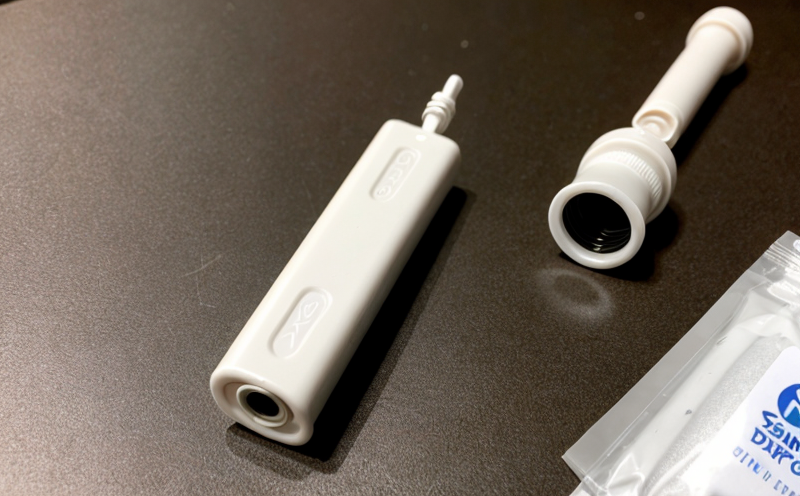ISO 7886 Syringe Nozzle Retention Testing
The ISO 7886 standard specifies methods for determining the retention force of nozzles in syringes. This is a critical aspect of ensuring medical devices are safe and effective, particularly in applications where precision delivery of medication or fluids is paramount.
When conducting this test, it's essential to understand that the nozzle's retention strength plays a pivotal role in preventing accidental dislodgement during use, which could lead to improper dosing or contamination. The testing procedure outlined in ISO 7886 involves subjecting the syringe nozzle assembly to a specified force to assess its ability to withstand external stresses without failure.
The test setup typically includes a testing machine that can apply a controlled force perpendicular to the surface of the nozzle. This force is gradually increased until the nozzle dislodges from the barrel of the syringe. The maximum force at which this occurs is recorded as the retention force. This measurement must be consistent with the design specifications and regulatory requirements.
For quality managers and compliance officers, ensuring that devices meet these standards not only enhances patient safety but also mitigates legal risks associated with product failures. Compliance with ISO 7886 ensures that the medical device industry adheres to international best practices in manufacturing and testing.
R&D engineers benefit from this testing by gaining insights into design improvements needed to enhance nozzle retention force, thereby improving overall device performance. Procurement teams can use test results as a benchmark for selecting suppliers who meet stringent quality standards.
Accurate and consistent testing is crucial. Laboratories must be equipped with the latest instrumentation capable of applying precise forces and measuring them accurately. This ensures that the results are reliable and repeatable, which is essential for regulatory compliance and trust in the market.
The process involves thorough specimen preparation, ensuring that no external factors such as contamination or damage to the nozzle affect the test outcome. Specimens should be stored under controlled conditions prior to testing to maintain their integrity.
Real-world applications of ISO 7886 include a wide range of medical devices like insulin pens, IV catheters, and other single-use syringes used in hospitals and clinics around the world. Ensuring that these devices meet retention force standards is vital for maintaining patient safety and trust.
- ISO 7886-1:2019 specifies the mechanical test methods for determining the retention force of nozzles in syringes.
- ISO 7886-2:2019 provides guidelines for the use and interpretation of retention force data.
Benefits
The primary benefit of ISO 7886 syringe nozzle retention testing is the enhancement of patient safety. By ensuring that nozzles do not dislodge during use, this test minimizes the risk of improper medication delivery or contamination.
For manufacturers and suppliers, compliance with these standards can lead to increased market share and customer trust. It demonstrates a commitment to quality and regulatory adherence, which are crucial in maintaining a positive brand reputation.
The testing process also aids in improving product design. Engineers can identify areas for improvement based on test results, leading to more robust and reliable devices. This iterative approach ensures that products evolve continuously to meet the highest standards of performance and safety.
From a regulatory perspective, compliance with ISO 7886 ensures that medical devices meet international standards, facilitating smoother market entry in various countries. It also helps in avoiding potential legal issues by ensuring that all components function as intended under specified conditions.
The testing process is not only beneficial for the manufacturer but also for healthcare providers and patients. Accurate retention force data allows for better selection of devices during procurement, leading to improved outcomes for patients using these devices.
Environmental and Sustainability Contributions
- Eco-friendly testing methods: By ensuring that medical devices are safe and effective from the outset, ISO 7886 testing can reduce the need for reprocessing or replacement of defective devices, thereby minimizing waste.
- Reduced healthcare costs: Ensuring device reliability through rigorous testing reduces the likelihood of adverse events, which in turn leads to lower healthcare costs associated with treatment and recovery.
Competitive Advantage and Market Impact
Compliance with ISO 7886 can provide significant competitive advantages for medical device manufacturers. It demonstrates a commitment to quality and regulatory compliance, which is increasingly important in the global market.
Manufacturers that adhere to these standards are likely to see an increase in customer trust and satisfaction. This can lead to higher sales volumes and stronger brand loyalty. In addition, adherence to international standards can facilitate easier market entry into countries with strict regulatory requirements.
The testing process also helps manufacturers differentiate their products from competitors by ensuring that they meet the highest standards of performance and safety. This differentiation can be a key factor in winning contracts and securing long-term relationships with healthcare providers.





